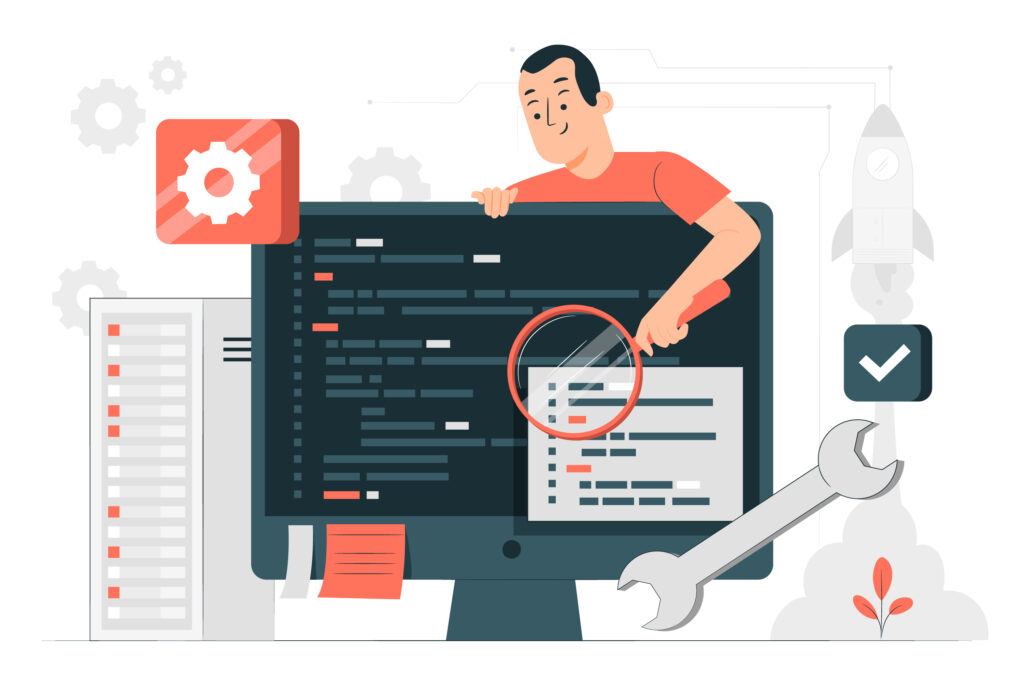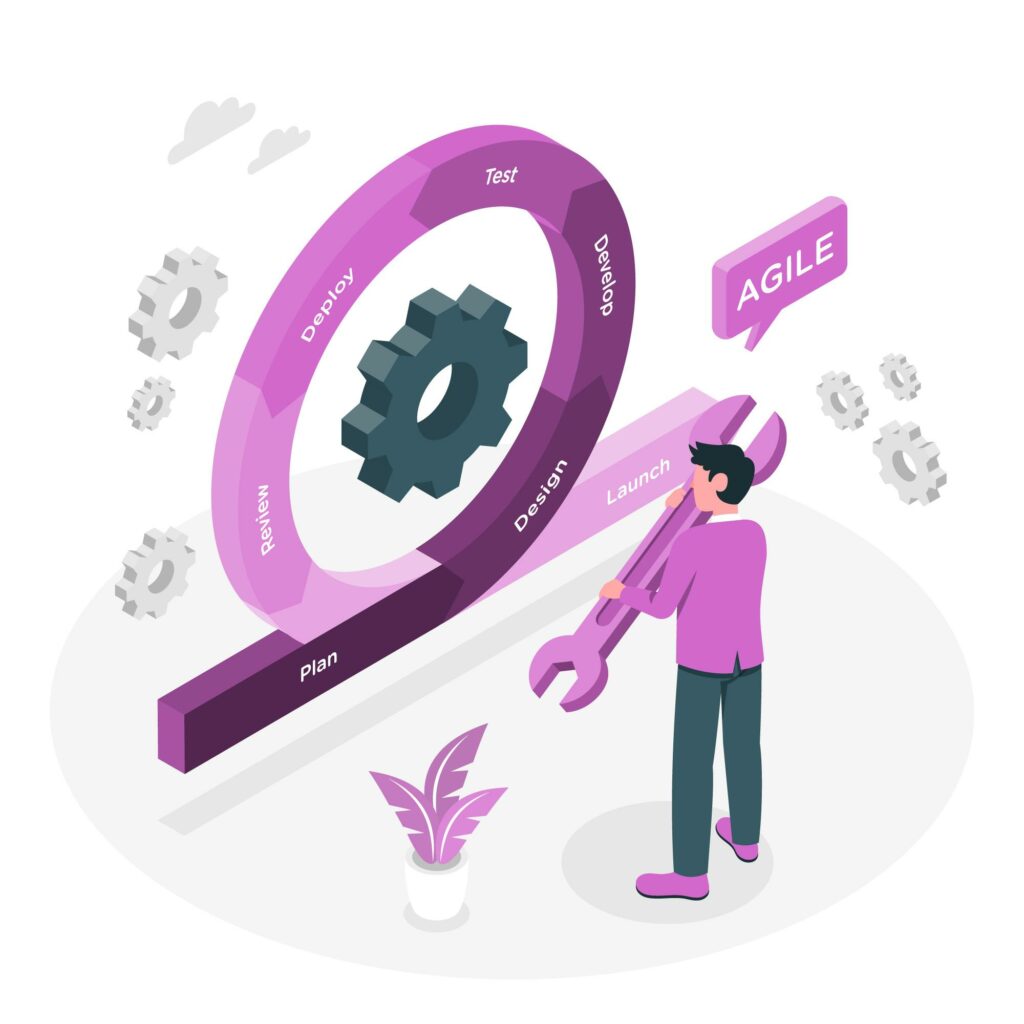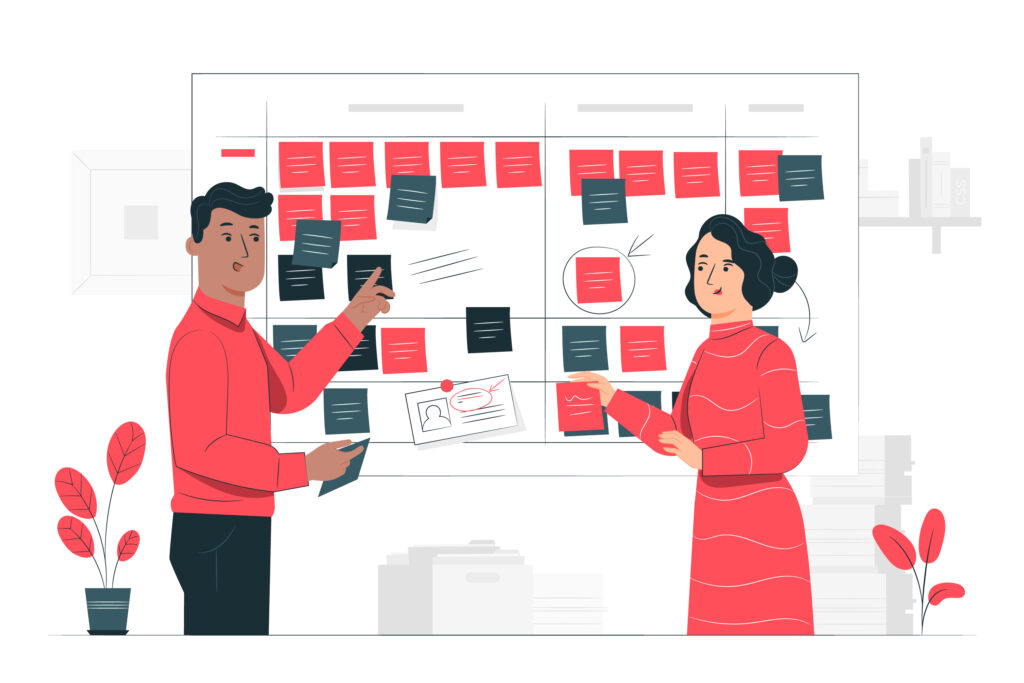How to Choose The Right Software Development Methodology For Your Project?
It is important to learn how to choose the right software development methodology for your project. Software development methodology refers to a set of processes, practices, and principles that guide software development.
It covers all stages of software creation, from initial planning and requirements gathering to coding, testing, deployment, and maintenance. Utilizing a software development methodology enhances project management, ensuring that projects are completed on time, within budget, and meet end-user requirements.

It also enhances quality control, teamwork efficiency, collaboration, communication, and stakeholder engagement. There are various software development methodologies, each with its strengths and weaknesses, which we’ll explore later in the article. The choice of methodology depends on several factors, including the project’s complexity, the size of the development team, the timeline, and the budget.
- Waterfall
- Agile
- KANBAN
- Scrum
- Design Thinking
- Lean Software Development
- Rapid Application Development
- Feature-Driven Development
- Rational Unified Process
- Importance of choosing the right software development methodology
- Understanding Project Requirements: Key Steps for Successful Software Development
- Key Steps to Successful Software Development
- How to Choose the Best Methodology for Your Software Development Project?
Waterfall
Waterfall provides less flexibility and is viewed as a non-agile framework. It is well-suited for small and straightforward projects with a clearly defined life cycle. The process involves distinct phases such as:
Analyze > Design > Build > Test > Deliver
A major drawback of this methodology for larger projects is the delayed opportunity for validation, potentially taking months before the client sees the product.
Advantages:
- Simple, easy to understand, gradual, and analytical process
- Suitable for software development beginners
- The rigidity of the model makes it very manageable
- Each phase has an individual review process and specific deliverables
- Tasks are processed and completed at once, saving a lot of time
- Simple operation makes testing and analysis easier
Disadvantages:
- Precise and up-front requirements are needed for this method to work
- Not suitable for maintenance or long, ongoing projects
- The development cycle must reach the final stage to produce working software
- Once the software is in the testing phase, making changes is not possible
Agile
Agile (KANBAN, Scrum) – Though these frameworks differ, they both focus on continuous delivery. Despite their popularity, implementing them without considering project requirements can lead to failure without proper training and a comprehensive agile transformation within the organization.

Advantages:
- Adaptive approach that responds to changing client requirements
- Feedback and direct communication with stakeholders and development teams reduce guesswork and minimize misunderstandings’
- Improved transparency between the client and the development team
- Quickly identifies and fixes errors and defects, catching mismatches between expectations and the actual product early on, enhancing end-product quality
- Working software can be produced before the final stage
Disadvantages:
- Focus on software and lack of documentation may cause operational issues
- Agile projects can go off track if the client’s objectives are unclear
KANBAN
Kanban focuses on lead time, tracking, and visualizing work in progress, providing a continuous cycle of development. It is suitable for both project development and stable support and maintenance. As a truly agile framework, it operates without the boundaries of sprints and specific team roles.

Scrum
Scrum operates in cycles called sprints, with the main KPI being the velocity or the amount of work the team can deliver within a given sprint. It enables product increments at a steady pace and requires specific roles and artifacts as tools within the framework.
Advantages:
- Development teams make all decisions and work at their own pace
- Business requirements documentation is not crucial for the project’s success
- Flexible method that handles frequent changes and updates, speeding up the development process
- Measures individual productivity in daily meetings, enhancing team member productivity
Disadvantages:
- Not suitable for large projects
- Requires an experienced team with a broad skill set working in close proximity
- Requires extensive planning due to the division of the project into sprints
Design Thinking
Advocated by Google in recent years, this framework provides a broad spectrum of methods for each phase of the project lifecycle. It emphasizes rapid analysis, design, prototyping, and building, enabling ideas to be validated quickly (in days or weeks) by obtaining early customer feedback.
It is an ideal framework for quickly building prototypes, developing working solutions, and validating them with end-users or stakeholders.

Lean Software Development
Lean is a flexible, strategically focused software development process that creates easily editable and changeable software solutions, making it ideal for limited budgets and minimal requirements. Applying lean manufacturing principles to software development, it aims to decrease programming efforts and defect rates, offering developers strong principles based on established rules.
This process requires detailed specification examination beforehand to eliminate wasted time or budget, with its core component being value for the client, making feedback and fast action crucial.
Advantages:
- Follows the core Agile Manifesto principle of “find good people and let them do their own job”
- Speedy process and reduced costs
- Developers can deliver more functionalities in a shorter period
- Development team has more decision-making freedom, empowering individuals and fostering motivation
Disadvantages:
- Project success depends on the team’s discipline and technical ability
- Additional training may be required
- Business analysts must ensure correct documentation and understanding
- Excessive flexibility may lead to poor focus, compromising the project.
Rapid Application Development
Feature-driven methodology is best suited for large teams working on project-oriented or object-oriented technology and organizations transitioning from stage-based to iterative approaches. It combines various software development practices and methodologies into one, prioritizing software development around its features and aiming for quick delivery of working products.

Advantages:
- Reduces risks of poor execution through constant client feedback and early issue detection
- Users interact with prototypes, resulting in higher-quality products
- Speedy development with less planning and documentation
- Transparent client and developer cooperation due to frequent feedback
Disadvantages:
- A relatively new and risky method
- Not suitable for small budget projects due to costs of modeling and automated code generation
- Requires an experienced team working together for an extended period.
Feature-Driven Development
This software development methodology is best suited for large teams working on project-oriented or object-oriented technology and organizations transitioning from stage-based to iterative approaches.
Feature-driven development combines various software development practices and methodologies into one, focusing on organizing software development around its features and delivering working products quickly.
Advantages:
- Facilitates the successful progression of large projects
- Provides structure and a clear project overview through five simple processes: model development, feature list building, planning, design, and build by feature
- Based on established standards for software development and industry best practices, making it easy for developers to grasp quickly
Disadvantages:
- Not suitable for smaller projects and teams due to complexity
- Lead developers require high training and full preparation as they bear significant responsibility
- Requires close monitoring at each phase to prevent major issues.
Rational Unified Process
The RUP methodology divides the software development life cycle into four phases: inception, elaboration, construction, and transition, each encompassing business modeling, analysis, design, implementation, testing, and deployment. Its primary aim is to achieve rapid results by leveraging assistance from other methodologies.
This adaptable, object-oriented process allows developers to access suitable guidelines, templates, and examples for all development stages. Teams can customize this framework to fit their organization, benefiting from fast prototyping and iterations that facilitate quick feedback and error elimination, leading to optimal product outcomes.
Advantages:
- Simplifies development process and facilitates quick client reviews
- Encourages client feedback
- Helps teams identify and resolve project risks associated with changing client requirements via request management
- Scalable and suitable for teams or projects of any size
- Reviews aid in maintaining focus and enhancing client-developer transparency
Disadvantages:
- A highly complex and potentially disjointed process requiring a skilled team
- Continued testing and integration increase complexity, potentially leading to new issues
- Dependency on team performance may be excessive.
The Importance of Choosing the Right Software Development Methodology
Importance of choosing the right software development methodology
It is essential to learnhow to choose the right software development methodology for your project. Selecting the appropriate software development methodology is crucial, much like laying a strong foundation for a building. It establishes the framework and guidelines for the entire development process. Here’s why it’s vital:
Alignment with Project Goals
Different projects have unique goals and requirements. Choosing the right methodology ensures that your development approach aligns with these objectives, allowing you to stay focused on achieving them.
Efficiency and Productivity
A well-suited methodology promotes efficient workflows and maximizes productivity. It streamlines communication, task allocation, and resource management, enabling software development teams to work more cohesively and deliver results in a timely manner.
Quality Control
The right methodology emphasizes code quality throughout the development lifecycle. It incorporates processes for testing, reviews, and feedback loops, enabling you to consistently produce high-quality software that meets user expectations.
Adaptability and Flexibility
Projects often encounter changes, whether in requirements, scope, or priorities. A suitable methodology provides the necessary flexibility to accommodate these changes while minimizing disruptions and ensuring project success.
Risk Mitigation and Quality Assurance
By breaking down the project into smaller, manageable units, risks can be addressed proactively, and quality can be continuously monitored and enhanced. The ability to adapt and make course corrections throughout the development process reduces the likelihood of major setbacks and improves the overall quality of the final product.
Understanding Project Requirements: Key Steps for Successful Software Development
Before starting any software development project, it’s essential to grasp the project requirements clearly. This phase sets the groundwork for the entire development process, ensuring that project goals are defined, constraints are identified, and project scope and complexity are analyzed.

In this blog post, we delve into the importance of understanding project requirements and provide a step-by-step guide to effectively define goals, identify constraints, and analyze project scope and complexity.
1. Defining Project Goals and Objectives
Collaboration with Stakeholders: Engage with project stakeholders, including clients, end-users, and key team members, to gather insights and perspectives. Conduct meetings, interviews, and workshops to understand their expectations, desired outcomes, and specific goals.
SMART Goals: Establish Specific, Measurable, Achievable, Relevant, and Time-bound (SMART) goals. Ensure that the goals are clearly defined and align with the overall purpose of the project. For instance, a goal could be to develop a user-friendly e-commerce platform that increases online sales by 20% within six months.
Prioritization: Prioritize project goals based on their importance and urgency. This helps in resource allocation, setting milestones, and managing expectations effectively.
2. Identifying Project Constraints and Limitations
Resource Limitations: Identify constraints related to resources such as budget, time, personnel, and technology. Determine the available resources and understand any limitations that may impact the project’s execution and delivery.
Technical Considerations: Evaluate the technological landscape, including existing systems, infrastructure, and compatibility requirements. Identify any constraints imposed by the technology stack or external dependencies.
Regulatory and Compliance Factors: Determine if there are any legal or regulatory requirements that need to be adhered to during the development process. Consider privacy, security, data protection, and industry-specific regulations.
Organizational Constraints: Take into account any internal constraints within the organization, such as policies, team availability, and communication protocols. Understanding these constraints helps in planning and resource allocation.
Key Steps to Successful Software Development
1. Analyzing Project Scope and Complexity
Functional requirements are essential in software development as they define specific functionalities and features. This includes user interactions, data handling, integrations, and desired outcomes. By identifying and documenting these requirements, you provide a clear roadmap for the software development team and stakeholders to follow.
It helps manage scope creep effectively by setting boundaries and avoiding unnecessary additions or changes.
Non-functional requirements also play a crucial role in shaping the software’s overall quality and user experience. Consider aspects such as performance, scalability, security, usability, and accessibility. These requirements ensure that the software not only functions properly but also meets desired standards in performance, security, and user satisfaction.
2. Understanding Stakeholder Expectations
When identifying project requirements, it’s essential to analyze the expectations and needs of all stakeholders involved, including clients, end-users, project managers, and development team members.
Understanding their pain points, preferences, and desired outcomes allows you to align the project scope and prioritize features accordingly. By considering stakeholder expectations, you can ensure that the software meets their needs and delivers the expected value.
3. Conducting Risk Assessment
Conducting a risk assessment is crucial to identify potential risks and challenges that may arise during the project. Evaluate areas of uncertainty, dependencies, and external factors that may impact the project’s success. By identifying risks early on, you can develop mitigation strategies to address them proactively and ensure project success.
Determine the Risks and Minimize Them
Understanding potential risks allows you to develop risk mitigation strategies and contingency plans to minimize their impact on the project. This proactive approach helps manage potential obstacles and ensures a smoother development process. Effective planning and resource allocation are crucial in this phase, setting the stage for a more efficient development journey.
In the next sections of this blog series, we will explore various software development methodologies to help you choose the most suitable one for your project, based on the requirements established in this phase.
How to Choose the Best Methodology for Your Software Development Project?
Selecting the right software development methodology is crucial and can significantly impact your project’s success.

To make an informed choice, consider factors such as project size, software development partner, client involvement, time constraints, and flexibility requirements. In this blog post, we’ll explore these factors and how they influence methodology selection.
Large Projects:
Agile methodologies, like Scrum or Kanban, offer flexibility and collaboration, making them suitable for large-scale projects with extensive requirements and multiple subsystems. Unlike the rigid sequential process of Waterfall, Agile allows for adaptability and continuous improvement.
Projects are broken down into manageable iterations (sprints in Scrum or work-in-progress limits in Kanban), enabling continuous feedback, adjustment, and prioritization of tasks.
Smaller Projects:
For smaller projects with well-defined scope, Agile methodologies are advantageous. They enable teams to respond efficiently to changing requirements and priorities, ensuring alignment with desired outcomes through short feedback loops and regular communication.
Complex Projects:
Complex projects with intricate dependencies or technical challenges can also benefit from Agile methodologies. Agile enables teams to break down tasks into smaller units, facilitating incremental progress and early issue identification. Continuous learning, risk mitigation, and adaptability are essential for navigating the complexities of such projects.
Agile methodologies offer flexibility and collaboration, applicable not only to small projects but also to large-scale and complex endeavors. By embracing Agile practices, teams can enhance their ability to respond to change, foster collaboration, and deliver high-quality results aligned with project goals.
[Want to learn more on how to choose the right software development methodology for your project? Click here to reach us.]
Conclusion
In conclusion, we have now seen how to choose the right software development methodology for your project. selecting the appropriate software development methodology is a critical decision that significantly impacts the success of your project. By carefully considering factors such as project size, complexity, client involvement, and time constraints, you can make an informed choice that aligns with your project’s unique needs and goals.
Whether you opt for the flexibility of Agile methodologies like Scrum or Kanban for large-scale projects, the efficiency of Agile for smaller projects, or the adaptability of Agile for complex endeavors, the key is to prioritize collaboration, communication, and alignment with project objectives.
Remember, the right methodology sets the stage for a smoother development journey and ultimately leads to the successful delivery of high-quality software solutions. With Bobcares‘ software development support services, you gain access to all the advanced expertise and assistance needed to navigate these methodologies effectively, ensuring optimal outcomes for your projects.







0 Comments